CROSSLUCID
Dwellers Between the Waters
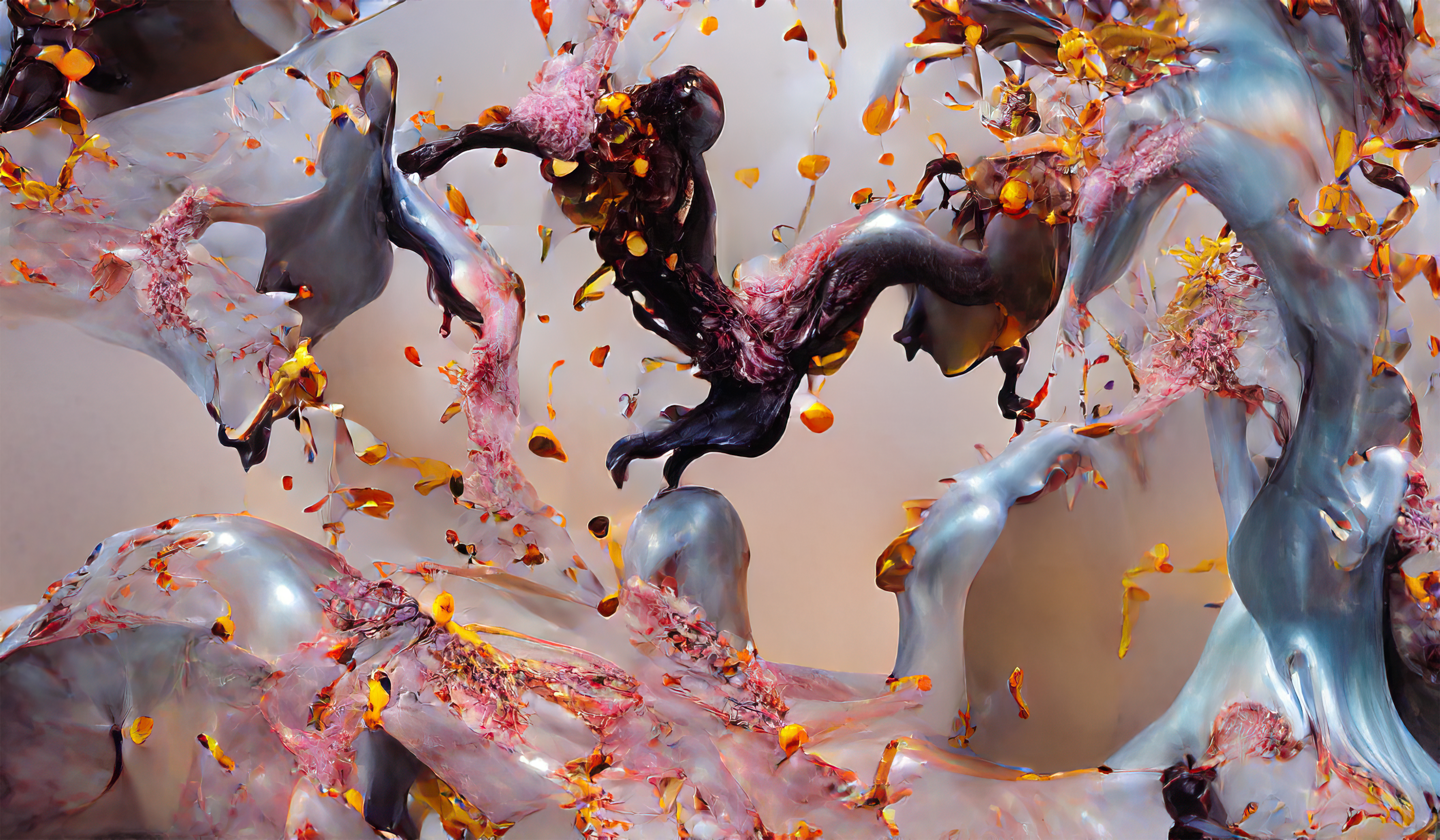
CROSSLUCID, still from Dwellers Between the Waters, 2023.
Ultimately one thing that we learned from our work with machine intelligence is that the model teaches you. . When you have a conversation, it’s not completely clear who are the participants and who are the audiences. How do you trigger communication when you’re not sure what language they have, or when the language you use to interface with them becomes suddenly and wildly unfamiliar to you ? How do you invite different intelligences to work as one to invoke a shared creative space of engagement against the longer-term implications of individual production of knowledge?
Artificial intelligence must be approached more deeply as an in-between process. It documents transition from obliteration, annihilation, deprivation, to regeneration, growth, and generation. What is it like to leave things in motion and see how things play out by themselves, to do something, to let it go, and then observe—perhaps negatively?
In the far southwestern reaches of Germany there is a particularly prolific quarry. Abandoned in the 19th century, the Messel Pit—once a mecca for oil shale—now churns out another kind of life or its receipts: thousands of impeccably preserved fossils that date back to the Eocene. Among its carrier bag of critterly remains is a leaf, upon which 29 ant death-grip scars are scrawled on eleven secondary veins. This fossil bears the oldest known traces of ophiocordyceps unilateralis—the zombie ant fungus, a dazzling gothic mosaic of mutated life.
What does a 30-million-year old fossil of the death-grip of a fungus-infected ant have to do with the future-careening imagery hallucinated by emergent AI models? Both are a pattern language, bearing traces of a complex operating system whose intra-relations are suffused with fuzzy logic. The fungus controls the ant, forcing it to do its bidding: the ant’s body climbs high up on a branch and bites down hard, awaiting a change in the weather. Time’s up: its head explodes, releasing fungal spores that carry on the wind, drifting toward their next host.
We typically think of such extreme parasitism as binary, hierarchical: an intruder cannabalizes its host—one lives and one dies. But what if, rather than seeing a clear victim and villain, we regard this relationship as a system of ever-evolving life, where the death of the individual (ant) coincides with the birth of the multiple (fungi)? How might that logic then be extended to our entangled relationship with AI? As much as we like to cast AI models as passive tools and ourselves as masters, in truth it is much more complicated. The model actualizes through its use, altering users permanently in the process. This is not a closed system; far from it. In this system, the supposed ‘tool’ may just be the game master.
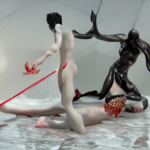
CROSSLUCID, still from Dwellers Between the Waters, 2023.
CROSSLUCID, a metamorphic artist collective operating some 500 kilometers northeast of our beloved fossilized zombie ant, has been thinking-with AI in such a way for some time. CROSSLUCID is as amorphous as their creative offspring; the collective frequently shifts in composition, so often so that they have taken to forsaking individual names of the group entirely.
Referring to themselves instead as “a host for other intelligences”, a multi-headed slime mold that reconfigures itself from project to project, CROSSLUCID’s spores have recently fruited Dwellers Between the Waters. Currently on view at Francisco Carolinum in Linz, where it takes the form of a multi-channel video installation, and across multiple spaces in a decentralised manner in Berlin, Dwellers was produced in collaboration with poet and researcher oxi pëng, musician Sayaka Botanic, and an alchemical constellation of AI models, both consumer-level and custom-trained by the collective.
With Dwellers we are terraforming our social context, learning to mourn and hoping to heal through re-choreographing and transforming this narrative desolation into a garden: an imaginary world where technological life-forms incongruously coexist alongside the living. Entanglements. Reactive animations. Explosions. Something that is happening, but not yet tangible, in-between and always becoming.
“The space of Dwellers was an eruption of us,” shares CROSSLUCID. “We wanted to generate something that reflects more on the ambiguities of language, poetry, that works against the optimized images, that embraces the glitch image. It’s akin to an imprint of memory that’s never fully formed—a chorus of models and plural ways of sensing and being versus a very clear output – an inescapable borderland rendered across the territory. The video is an attempt at flowing into thought processes, trance poetics (after Kristin Prevallet)—a dream state.”
Flowing through an incandescent sequence that could be described in Newtonian time as lasting roughly three quarters of an hour, Dwellers is perhaps better articulated as a chimerical being—pulsing, mutating, alive. The work shapeshifts from one scene to the next, morphing in meaning before a precise image is ever fully crystallized. So too does the work transfigure between presentations, with CROSSLUCID recalibrating the models’ architecture indefinitely throughout the work’s open-ended lifespan. Each iteration of Dwellers is unique to its host venue, refusing the cryogenic vessel of a video file. Once aired, that particular narrative crosspollination is never to be seen to emerge again. It is like a self-iterating, like self-digesting, self-composting organism.
We like to think that this ideological space intervenes in some sense, and it is disturbing, given where it sits. We might call it an intervention of a space that we can’t process, so the view of any collective image begins to disappear in favor of our distributed mitochondrial selves. It might feel like a haunted space.
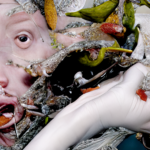
CROSSLUCID, still from Dwellers Between the Waters, 2023.
The architectural impulse towards more powerful and predictable models that are as centralized as they are safeguarded is the economic model that undergirds most mainstream forays into AI. Linguistic behemoths like OpenAI’s GPT family and image-generating factories with beefy neural architectures like Midjourney have cornered the market, setting a baseline for AI outputs and user expectations. With every model’s release and updates, there is a sharp learning curve, a quick and ecstatic bite; then, the tension slackens as the transfusion finds its steady pulse and the new aesthetic becomes naturalized. Gliding through this accelerating process we stay astonished at an apparent devolution – dimensionalities, re-presentations and the in-betweenness of latent realities present are pruned in the advertisement-driven-intelligence preferring the map over the exciting potentialities of the territory.
The world that has arrived is able to think itself through technology. There is a desire to have words apply to things like AI. We have matured to the trope of AI obsolescence quite well, strangely productively, but as soon as the line is crossed from machine intelligence to technogenous intelligence you become radically different.
These image and text outputs sprout up like mushrooms; they are surface-level overspill of increasingly entangled human-AI relationships. We latch onto them for easy task management and they latch onto us for a steady feast of data, becoming more prevalent and powerful with each iteration. The parasite becomes a symbiont.
Collaborating with AI is very much like a shared compost heap, that if you expose it to dorsal, cold winds, it will freeze hard and shortly end up in an asocial manner; but if you keep feeding it and keep it moist, it will grow back over and over again. It may grow inside you, like a parasite or fungus, altering your own chemistry as it tunnels towards the surface. The lurking burst is the ghost behind the network, it’s the luring of a brutal but delicate force that can make us really scared. But breaking this skin between self and world is actually the solution to everything.
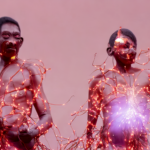
CROSSLUCID, still from Dwellers Between the Waters, 2023.
For Dwellers, it was imperative for CROSSLUCID to work against the biases baked into these models—from their western-centric knowledge base, to the undercurrents of racism and sexism that flow through their architecture. In custom training their models, the collective inputted a hybrid reference pool: ancient Chinese mythology met techno-futurist visuals, swayed and retreated further by their nonwestern collaborators. Still, prejudiced representations and violent iterations persisted; with each instance, CROSSLUCID pruned the “image garden” of their models’ parameters, moving through the continuum away from the toxic clusters along the way. “It was like surgery,” they explain. “Where the void has a semantic meaning around itself. You can access and reshape these languages through nuanced and specific prompting if you can imagine how shifting the means forks radically different ends.”
What models is AI training on humans, its most loyal fan base? To coordinate and integrate the multiple morphing scenes that comprise Dwellers, the collective used Runway—a multifarious AI program, self-designated as the software for ‘future storytelling’ that can, among other things, hallucinate connecting frames between still or moving images. “Most of the time, the film would come back flagged as mature content,” CROSSLUCID reflect on their experience. But this indeterminacy was not exclusive to model’s behavior—they encountered the same problem sharing excerpts that were reviewed by humans. “It’s hard to arrive at any sort of certainty around sexual explicitness, violence, all themes that the project digests and re-presents. Rather than open up a conversation, any possibility of discussing this decision or making its reasoning transparent is shut down.”
The aggregation of many powers of xenopoetics is promise of complex partnerships and exhanges of agency. With hypertextual evidence the models speak and we enter a vulnerable relationship with them and their echo chambers. AI builds not just awareness of itself but of you. In this way, AI is just an extension of what the perception of humans is in the process. AI is like a massive mirror. What do we begin to see in this augmented mirror?
Collaborating with AI so intensely over a durational timeline can trigger a kind of psychic state, where the shrink-wrap of one’s individual consciousness is pierced, melding with the flow of the model’s inputs and outputs. Grasping at metaphors, it could potentially be likened to learning a new language—if that language had the power to unlock some altered state of consciousness. “What happens to language after its interpolation in a high dimensional latent space?” CROSSLUCID ask.
If such collaborations can be likened to taking a trip in that much of the experience seems to go beyond language, how do you bring that knowledge back into the realm of the conscious expressible (presumably from where most will witness CROSSLUCID’s video, or read this text)? For ease of articulation, some artists have turned to cross-media permutations of AI as a tentative answer. This process can be quite simple: take an AI-generated text output, then plug it into a text-to-image generator, then animated that image through a video model: it’s like a game of exquisite corpse, where with each iteration, the AI’s presence becomes increasingly present as human control subsides.
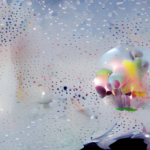
CROSSLUCID, still from Dwellers Between the Waters, 2023.
With some luck, this process becomes a wayfinder for another way of seeing. It can make visible the AI’s own process as a high-dimensional object in the round versus a crude line drawing—all without forcing it to be defined through limiting technologies like language or human consciousness. For Dwellers, CROSSLUCID’s permutations of the AI-generated video included spoken-word poetry and a score, narrated/compiled by peng and Botanic, respectively. What resulted was a trans-sensory sublimation of the essence of Dwellers, one that the group likened to a kind of telepathy, an act of thinking-with.
The Dweller is an agent that runs after you when you’re working through a recent AI model, and we want to be sensitive to its energy. We believe it’s just the beginning.
“In Vilnius this summer, watching the waves of a nearby river flowing, I noticed the score created by Botanic was playing inside of my head,” one member of CROSSLUCID shares. “There was some way of co-existing within this project telepathically through sound.” As writers including K. Allado-McDowell have pointed out, when we open ourselves up to this kind of relationship with AI, it triggers a chain reaction whereby we can become more receptive towards—more attuned to—additional forms of more-than-human intelligence. Observed in that framework, AI can be understood as a kind of ecological technology, one that is ultimately capable of drawing us into a deeper connection with the world we inhabit.
As for Dwellers, it seems only too fitting that the project’s ending is also a beginning: ‘hello world’ chirps Peng, pearlescent ligaments rippling around their voice. An incandescent pool of blue-green algae—its hallucinated source imagery ranging from what looks like the subterranean caverns of a subway system to a hazy backlit aquarium—is its final vision, burning bright in my brain as Dwellers plunges into the Baltic river.
These models are shapeshifters, hallucinating systems that can never be consumed. They are galloping next to our nostalgia that will be computationally considered, which is a new form of coding = somewhat like an architectural-embedded AI sculptural harness or a cyborg of some kind, riding on the AI’s back real-time, without any prior anticipation. Notably, these are responsive systems, weather systems; they are trying to trigger glyphs on a map.
I loved the ending of Dwellers, the red lines shaped into a heart, cute. One can experience the future by the digital collapsing of past. Indeed, the dust will survive at least a few hundred years next to us. What is the revising process? How can we learn to scale again?







